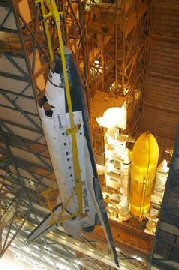|
Discovery’s Return to Space-3/29/05
A Progress Report, courtesy NASA
The Shuttle Discovery has completed the first of two major milestones on the path toward Return to Flight.
In the early morning hours of Tuesday, March 29, Discovery rolled over from the Orbiter Processing Facility to the Vehicle Assembly Building (VAB) at NASA's Kennedy Space Center. There it will be attached to its redesigned External Tank and twin Solid Rocket Boosters.
On Monday, April 4, Discovery begins its eight hour journey to launch pad 39B. Discovery's mission, STS-114, is targeted for launch in May.
"This is a tremendous accomplishment for the Space Shuttle Program," said Bill Parsons, Space Shuttle Program Manager. "This effort has taken a talented team dedicated to meticulously preparing the vehicle and implementing all the modifications for a safe Return to Flight," he added.
 Image at left: Suspended from an overhead crane in the Vehicle Assembly Building at NASA’s Kennedy Space Center, the orbiter Discovery is lowered toward the Solid Rocket Booster and External Tank (seen below) already stacked on the top of the Mobile Launcher Platform (MLP). After Discovery has been mated to the External Tank/Solid Rocket Booster assembly on the MLP and all umbilicals have been connected, workers will perform an electrical and mechanical verification of the mated interfaces to verify all critical vehicle connections. Click image to enlarge Image at left: Suspended from an overhead crane in the Vehicle Assembly Building at NASA’s Kennedy Space Center, the orbiter Discovery is lowered toward the Solid Rocket Booster and External Tank (seen below) already stacked on the top of the Mobile Launcher Platform (MLP). After Discovery has been mated to the External Tank/Solid Rocket Booster assembly on the MLP and all umbilicals have been connected, workers will perform an electrical and mechanical verification of the mated interfaces to verify all critical vehicle connections. Click image to enlarge
Credit: NASA/KSC. + View Photo Feature | + View More Photos.
* * *
Sea of Ice Found on Mars?
European Space Probe Finds Ice Close to Equator
The European Space Agency’s Mars Express spacecraft has taken pictures that suggest ice floated on a sea near the Martian equator just a few million years ago.
If the huge fractured plates do, indeed, prove to be ice, bacteria could certainly live on Mars, as geothermal energy could create liquid water close to the surface. Bacteria on Earth have been shown to occupy virtually any available niche, including pack ice in Antarctica.
NASA’s Mars rovers have found plentiful geologic evidence for water early in Mars' history. Perhaps a billions of years ago or longer, Mars was awash in water. What isn’t clear is what happened to it, or most of it.
But what is significant about the Express discovery is that large bodies of water may have existed in the geologically recent past.
Though covered by a dusty layer, the putative ice plate is about the size of the North Sea and at least 150 feet deep, according to scientists.
As reported in the New York Times and elsewhere, Dr. Jan-Peter Muller, a professor at University College London who is on the research team, compared the Martian features with similar ones in Antarctica. This "led us to the inescapable conclusion that what we're looking at is the fossilized remains of pack ice floating on a frozen sea."
Because the area, named Elysium Planitia, has few impact craters, the probability is that the lake formed and froze only two million to five million years ago. "That's yesterday in geology," Dr. Muller said. Mars is thought to be about 4.5 billion years old.
Later this spring, Mars Express will train its ground-penetrating radar instrument Elysium Planitia in an effort to determine if ice or rock underlies expansive plain. But as Dr. Muller points out, "This is a place we really ought to go after next time we send a lander to Mar
* * *
Book Your Outer-Space Vacations Now
Inventors, entrepreneurs and architects of the nascent industry of space tourism appeared before a House panel considering regulations for the new industry and admitted the inevitability of accidents as the new technology progresses along the learning curve.
“There are going to be fatalities,” said Michael Kelly, a member of a group that is setting industry safety standards for space fliers. “It's a risky business. ... This is not transportation, this is adventure.”
Virgin Galactic President Will Whitehorn, referring to Burt Rutan, winner of the $10 million Ansari X Prize for putting the first privately-funded man into space, said “If you see Burt Rutan as being like the Wright brothers in this industry... what we have before us is what existed before aircraft were developed in the early 1900s.''
Virgin Galactic and at least one other company are already taking reservations for space rides after Congress passed legislation in December creating the first regulatory framework for sending paying passengers into space.
The House Infrastructure and Transportation's aviation subcommittee was told that if they are flexible as they write their rules and regulations, out-of-this-world vacations could be widely available within two decades.
“It's reasonable to expect that by 2025 ... that this part of our industry will have developed to the point where there could potentially be many, many of these launches,” said John W. Douglass, head of Aerospace Industries Association of America.
Under the Commercial Space Launch Amendments Act of 2004, the FAA can wait up to eight years to issue regulations to protect the safety of passengers and crew, unless a serious safety problem, injury or death occurs before then.
FAA Administrator Marion Blakey agreed that the initial steps taken are enough for now but said that commercial space entrepreneurs other interested parties need to help evolve safety standards in conjunction with government regulators.
”It was more than 20 years after the Wright brothers' first flight before government regulations concerning aviation were put into place,'' she said.
Responding to the need to get out front on the issue, a group of Space entrepreneurs last month formed the Industry Consensus Standards Organization to set their own safety standards for space fliers.
Rutan, shortly after his Ansari-winning October flight, inked a deal with Virgin Galactic, part of Richard Branson's Virgin Group. The contract calls for five of his spacecraft to begin taking passengers on 2 1/2-hour trips in 2008, at a cost of $200,000 each.
“Given that we've got 18,000 people who've now approached us wishing to fly in the early years, and given that they read like a textbook of Hollywood, Congress itself, and international stardom, we're hardly likely to launch spaceflights which would kill these people,” Whitehorn said.--Ed.
* * *
Below is the letter of transmittal from Space Age Publishing Company regarding an updated "International Lunar Orbiter Fleet" database. The updated file is a PDF document, which we’ve linked to below.--Ed.
Dear Aerosphere:
Thanks to the European Space Agency's SMART-1, following Russian, American and Japanese lunar orbiters decades earlier, humanity once again maintains a rightful presence at its closest celestial neighbor -- the Moon. Hopefully Luna, so close and holding so many answers to humanity's questions and solutions for humanity's future, will never again be without this vital activity. Six missions are currently planned to follow SMART-1 to the Moon.
Attached to this email is the new "International Lunar Orbiter Fleet" Comparative Database for March 2005 as an Adobe Acrobat (PDF) file. Since the release of the 1st ILOF Database in May 2004, Space Age Publishing Company has compiled extensive update information relating to the seven international lunar orbiter missions taking place now through 2008. This table is intended as an informational tool to help clarify understanding of current efforts regarding humanity's return to the Moon. These lunar orbiters will inevitably be followed by landingmissions, and subsequently, by human missions.
We hope you can utilize this valuable information in future articles/papers you may produce, or that it can be of personal use or interest to you. Feel free to contact Space Age with any questions. We wish you all the very best in your endeavors.
With Aloha, Sincerely, the Editors at Space Age
|
